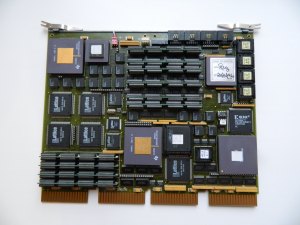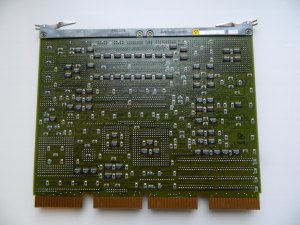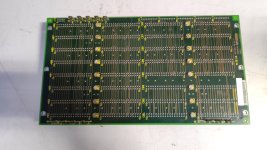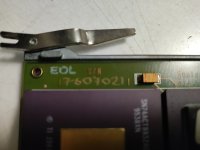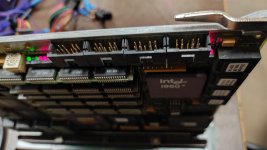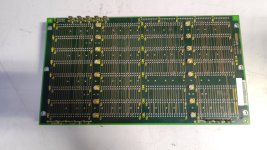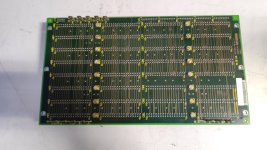Hunta
Veteran Member
I got here a very interesting and not often seen Mentec M11 board 
Thanks to my friend!
Photo
So, the log (but not the first one at all) of the download:
As can be seen from the title - the board is not at all like the M11, but it seems to be very close to it, according to first impressions - the modified contents of the initial ROM.
The board started quite well (although there are some incomprehensible moments here) in a standard DEC H9278-A and successfully booted (via the help of HX) with a CF card.
Unfortunately the firmware version is 1.15 and FPP is only available from version 2 or higher, so - no FPP.
According to the documentation - even with the required version of the FPP microcode (implemented using the i960) it differs from the standard DEC - it has 2-3 lower digits less (as I understand it - binary) the result is less (that is, DEC FPP calculates more accurately )
)
The first thing that comes to mind is how fast the board is Ok, the first test is with my SPEED3.
Ok, the first test is with my SPEED3.
I draw your attention to the fact that KDJ11-B (24 MHz!) was tested with a hit in the cache (that is, this is its MAXIMUM performance), but there is no cache on the M11, but it has fast memory - therefore SPEED3 was used (and SPEED4 showed about the same results).
Well, I'm a famous fan of RSX-11, more specifically - M-Plus, there is one on flash drives, so then I tried to load it and ... when I saw how RSX recognized the board, I specifically choked The result was EXTREMELY unexpected ...
The result was EXTREMELY unexpected ...
Thanks to my friend!
Photo
So, the log (but not the first one at all) of the download:
Code:
M11 Microcode Rev. V 1.15
Loading microcode - 1 2 3 4 5
Testing in progress please wait
4088 K Bytes RAM
M1000 SIEMENS BOOTSTRAP / DIAGNOSTIC VERSION V 2.1
Commands are :
BOOT - Boot from a specific device.
HELP - Re-display this summary of commands.
LIST - List the bootstraps provided.
MAP - Display a map of the address space.
SETUP - Configure the M1000.
TEST - Enter a continuous test mode
Enter a command and press the return key :
00037176
@177776/055433 177777
@10000/012706 12706
010002/011546 10000
010004/010600 12746
...(the process of entering quite a standard bootloader has been cutted)
010124/000000 4715
010126/000000 4715
010130/000000 5007
@10000G
HX 2.2 RT-11 Cold boot..
HX DSK/TTY multiplexer v3.3 2016
RT-11SB (S) V05.07
.R MSCPCK
.BOO ZB1:RT11SB
RT-11SB (S) V05.07
.R MSCPCK
.SHO ALL
RT-11SB (S) V05.07
Booted from ZB1:RT11SB
USR is set SWAP
EXIT is set SWAP
KMON is set NOIND
MODE is set NOSJ
TT is set NOQUIET
ERROR is set ERROR
SL is set OFF
EDIT is set KED
FORTRAN is set FORTRA
KMON nesting depth is 3
Global .SCCA flag is disabled
CLI is set DCL, CCL, UCL, NO UCF
PDP 11/73A Processor
4088KB of memory
Floating Point Microcode
Extended Instruction Set (EIS)
Memory Management Unit
Parity Memory
ECC Memory
Cache Memory
50 Hertz System Clock
Memory parity support
SB timer support
Global .SCCA support
FPU support
Extended unit support
Device Status CSR Vector(s)
------ ------ --- ---------
RK Installed 177400 220
DL Not installed 174400 160
DU Not installed 172150 154
HX Installed 177560 000
ZA Installed 161014 350
ZB Resident 161054 354
ZC Installed 161114 360
ZD Installed 161154 364
ZE Not installed 161214 370
ZF Not installed 161254 374
WQ Not installed 177134 204
WS Not installed 177134 204
LD Installed 000000 000
VM Installed 177572 250
MU Not installed 174500 260
NL Installed 000000 000
SL Installed 000000 000
EM Installed 000000 010
DD Installed 176530 330 334
TT (Resident)
ZB (Resident)
ZB1 = DK , SY
HX
RK
ZA
ZC
VM
ZD
LD
NL
SL
EM
DD
13 free slots
Job Name Console Level State Low High Impure
--- ---- ------- ----- ----- --- ---- ------
0 RESORC 0 0 Run 000000 135204 137076
No multi-terminal support
Address Module Words
------- ------ -----
160000 IOPAGE 4096.
157200 ZB 192.
135250 RMON 4588.
001000 ..BG.. 23636.
No LD units mounted
.As can be seen from the title - the board is not at all like the M11, but it seems to be very close to it, according to first impressions - the modified contents of the initial ROM.
The board started quite well (although there are some incomprehensible moments here) in a standard DEC H9278-A and successfully booted (via the help of HX) with a CF card.
Unfortunately the firmware version is 1.15 and FPP is only available from version 2 or higher, so - no FPP.
According to the documentation - even with the required version of the FPP microcode (implemented using the i960) it differs from the standard DEC - it has 2-3 lower digits less (as I understand it - binary) the result is less (that is, DEC FPP calculates more accurately
The first thing that comes to mind is how fast the board is
Code:
.RUN SPEED4 .RUN SPEED3
Performance test (cache, if present, enabled) Performance test (cache, if present, disabled)
BR .+2 1 470 536 op./sec 1 743 468 op./sec
R1+R0 classic 649 575 op./sec 6 965 368 op./sec
R0(23456.)+R0(12345.) empty 1 470 517 op./sec 1 741 341 op./sec
R1(23456.)+R0(12345.) 1 180 902 op./sec -> 5 996 017 op./sec 1 393 073 op./sec -> 6 965 369 op./sec
R1+@R0 classic 309 949 op./sec 1 268 117 op./sec
R1(23456.)+@R0(M-12345.) empty 1 470 518 op./sec 1 741 341 op./sec
R1(23456.)+@R0(M-12345.) 847 196 op./sec -> 1 998 673 op./sec 733 761 op./sec -> 1 268 115 op./sec
R0*R0 classic 271 590 op./sec 465 063 op./sec
11.*12. empty 1 470 518 op./sec 1 741 341 op./sec
11.*12. 229 931 op./sec -> 272 546 op./sec 340 192 op./sec -> 422 788 op./sec
R2/R0 classic 161 716 op./sec 398 632 op./sec
R2-R3(34567.)/R1(321.) empty 1 180 902 op./sec 1 393 073 op./sec
R2-R3(34567.)/R1(321.) 152 808 op./sec -> 175 520 op./sec 316 982 op./sec -> 410 354 op./sec
MOV 8 word 1 empty 962 804 op./sec 1 160 894 op./sec
MOV 8 word 1 56 903 op./sec -> 60 477 op./sec 58 375 op./sec -> 61 465 op./sec
MOV 8 word 2 empty 964 010 op./sec 1 160 894 op./sec
MOV 8 word 2 69 267 op./sec -> 74 629 op./sec 70 311 op./sec -> 74 844 op./sec
R1 := M(word) 1 468 650 op./sec 1 267 742 op./sec
R1 := M(even byte) 1 470 519 op./sec 1 267 742 op./sec
R1 := M(odd byte) 1 470 519 op./sec 1 267 742 op./sec
#4+R0(2000) empty 1 247 782 op./sec 3 482 684 op./sec
#4+R0(2000) 1 470 518 op./sec -> 0 op./sec 1 741 341 op./sec -> 3 482 680 op./sec
CMP (R0)+,(R0)+ empty 1 247 782 op./sec 3 482 684 op./sec
CMP (R0)+,(R0)+ 742 313 op./sec -> 1 832 446 op./sec 606 412 op./sec -> 734 263 op./sec
#2+R0(2000) empty 1 247 782 op./sec 3 482 684 op./sec
#2+R0(2000) 1 470 518 op./sec -> 0 op./sec 1 741 341 op./sec -> 3 482 680 op./sec
INC R0 INC R0 empty 1 247 781 op./sec 3 482 683 op./sec
INC R0 INC R0 1 470 518 op./sec -> 0 op./sec 1 741 341 op./sec -> 3 482 681 op./sec
TST (R0)+ empty 1 247 782 op./sec 3 482 683 op./sec
TST (R0)+ 1 180 903 op./sec -> 22 032 469 op./sec 930 305 op./sec -> 1 269 387 op./sec
CLR R0 - SOB R0, . empty 649 575 op./sec 6 965 367 op./sec
CLR R0 - SOB R0, . 18 op./sec -> 18 op./sec 21 op./sec -> 21 op./sec
ABS1 259 821 op./sec 155 419 op./sec
ABS2 1 180 916 op./sec 1 393 979 op./sec
ABS2+ empty 1 249 492 op./sec 3 482 684 op./sec
ABS2+ 847 202 op./sec -> 2 631 365 op./sec 995 514 op./sec -> 1 393 978 op./sec
ABS2- empty 1 247 781 op./sec 3 482 683 op./sec
ABS2- 986 595 op./sec -> 4 713 324 op./sec 1 266 617 op./sec -> 1 990 565 op./sec
ABS3 1 470 517 op./sec 1 393 526 op./secI draw your attention to the fact that KDJ11-B (24 MHz!) was tested with a hit in the cache (that is, this is its MAXIMUM performance), but there is no cache on the M11, but it has fast memory - therefore SPEED3 was used (and SPEED4 showed about the same results).
Well, I'm a famous fan of RSX-11, more specifically - M-Plus, there is one on flash drives, so then I tried to load it and ... when I saw how RSX recognized the board, I specifically choked
Code:
.BOO/FOR D40:
RSX-11M-PLUS V4.6 BL87 2044.KW System:"KXX03 "
>RED ZD1:=SY:
>RED ZD1:=LB:
>RED ZD1:=SP:
>MOU ZD1:"RSX11MPBL87"
>@ZD1:[1,2]STARTUP
>; PLEASE NOTE
>;
>; If you have not yet read the system release notes, please do so
>; now before attempting to perform a SYSGEN or to utilize the new
>; features of this system.
>;
>;
>* Please enter time and date (HH:MM DD-MMM-YYYY) [S]: 16:30 5-NOV-2022
>TIME 16:30 5-NOV-2022
>ACS SY:/BLKS=1024.
>CON ONLINE ALL
... (deleted because not interested)
>ACD INSTALL LB1:[ACD2]MIMACD.TSK AS NUMBER 20 ASSIGN ACD$MIM
>ACD LINK TI: TO NUMBER 20
>@ <EOF>
>CON DISPL ATTR FOR SYS
SYS
PDP-11/96, EIS,UNIBUS_Map,D-Space,Cache,
Clock=KW11-L, $TKPS=50., $TTPRM=000002, Cache_control=000001
